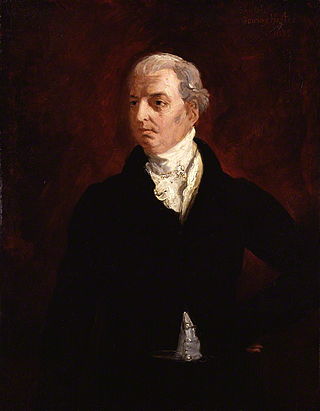Top Qs
Timeline
Chat
Perspective
Liverpool ministry
UK cabinet From Wikipedia, the free encyclopedia
Remove ads
Robert Jenkinson, 2nd Earl of Liverpool was invited by the Prince Regent to form a government on 8 June 1812.[1] This is a list of members of the government of the United Kingdom in office under the leadership of Lord Liverpool from 1812 to 1827. He was appointed Prime Minister of the United Kingdom by the Prince Regent after the assassination of Spencer Perceval.
Remove ads
History
Cabinet
1812–1827
- Robert Jenkinson, 2nd Earl of Liverpool – First Lord of the Treasury and Leader of the House of Lords
- John Scott, 1st Earl of Eldon – Lord Chancellor
- Dudley Ryder, 1st Earl of Harrowby – Lord President of the Council
- John Fane, 10th Earl of Westmorland – Lord Privy Seal
- Henry Addington, 1st Viscount Sidmouth – Secretary of State for the Home Department
- Robert Stewart, Viscount Castlereagh (Lord Londonderry after 1821) – Secretary of State for Foreign Affairs and Leader of the House of Commons
- Henry Bathurst, 3rd Earl Bathurst – Secretary of State for War and the Colonies
- Robert Dundas, 2nd Viscount Melville – First Lord of the Admiralty
- Nicholas Vansittart – Chancellor of the Exchequer
- Henry Phipps, 1st Earl of Mulgrave – Master-General of the Ordnance
- Robert Hobart, 4th Earl of Buckinghamshire – President of the Board of Control
- Charles Bathurst – Chancellor of the Duchy of Lancaster
- John Jeffreys Pratt, 1st Marquess Camden – minister without portfolio
Changes
- Late 1812 – Lord Camden leaves the Cabinet
- September 1814 – William Wellesley-Pole (Lord Maryborough from 1821), the Master of the Mint, enters the Cabinet
- February 1816 – George Canning succeeds Lord Buckinghamshire at the Board of Control
- January 1818 – Frederick John Robinson, the President of the Board of Trade, enters the Cabinet
- January 1819 – Arthur Wellesley, 1st Duke of Wellington succeeds Lord Mulgrave as Master-General of the Ordnance. Lord Mulgrave becomes minister without portfolio
- 1820 – Lord Mulgrave leaves the cabinet
- January 1821 – Charles Bathurst succeeds Canning as President of the Board of Control, remaining also at the Duchy of Lancaster
- January 1822 – Robert Peel succeeds Lord Sidmouth as Home Secretary
- February 1822 – Charles Williams-Wynn succeeds Charles Bathurst at the Board of Control. Bathurst remains at the Duchy of Lancaster and in the Cabinet
- September 1822 – Following the suicide of Lord Londonderry, George Canning becomes Foreign Secretary and Leader of the House of Commons
- January 1823 – Vansittart, elevated to the peerage as Lord Bexley, succeeds Charles Bathurst as Chancellor of the Duchy of Lancaster. F.J. Robinson succeeds Vansittart as Chancellor of the Exchequer. He is succeeded at the Board of Trade by William Huskisson
- 1823 – Lord Maryborough, the Master of the Mint, leaves the Cabinet. His successor in the office is not a Cabinet member
Remove ads
Full list of ministers
Summarize
Perspective





Members of the Cabinet are in bold face.
- Notes
- Created Earl of Eldon in July 1821.
- Succeeded as Marquess of Londonderry, 6 April 1821.
- Styled as Earl of Mount Charles after 1824.
- Became Sir John Osborn, Bt, in 1818.
- Created Baron Bexley 1 March 1823.
- Succeeded as Baron Downes, 3 March 1826.
- Created Baron Maryborough 17 July 1821.
- Created Marquess Camden in September 1812.
Remove ads
References
Wikiwand - on
Seamless Wikipedia browsing. On steroids.
Remove ads


